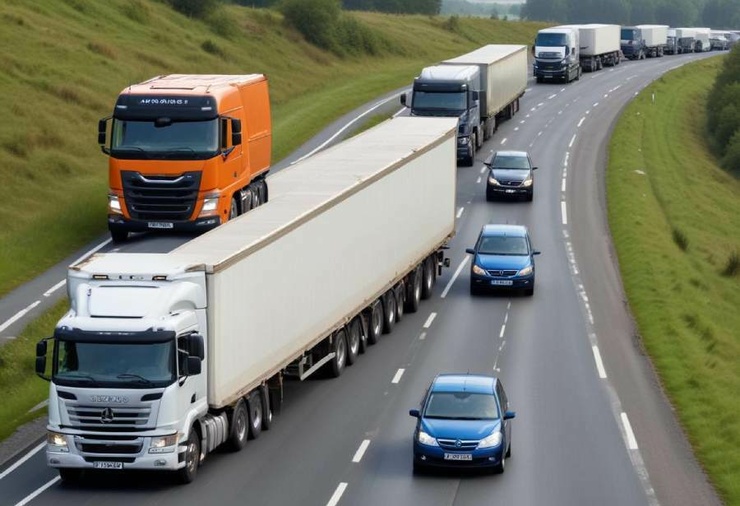- Route
What is Vehicle Routing in Logistics?
Table of Contents
- What is Vehicle Routing?
- Common Approaches to Vehicle Transportation Routing
- Real-World Applications of Vehicle Routing and dispatch
- Benefits and Impacts of Vehicle Routing: Enhancing Efficiency and Satisfaction
- Future Trends in Vehicle Routing
- The FarEye Advantage: Empowering Businesses with Efficient Vehicle Routing

Vehicle routing plays a pivotal role in modern transportation systems across various industries. As the backbone of logistics and delivery operations, efficient vehicle route optimization can lead to substantial cost savings, reduced environmental impact, and improved customer satisfaction. In this blog, we delve into the intricacies of vehicle routing, exploring its fundamentals, common optimization approaches, real-world applications, benefits, and future trends.
What is Vehicle Routing?
It's a strategic process that goes beyond mere navigation, aiming to orchestrate a symphony of movements that ensure timely deliveries, cost-effective operations, and minimal resource wastage. Let's delve deeper into the essence of vehicle routing to grasp its significance and mechanics.
Vehicle route optimization is the meticulous planning of optimal routes for a fleet of vehicles, each with its designated purpose, be it delivering products, providing services, or collecting resources. It's a puzzle-solving endeavor that entails determining the most efficient way for these vehicles to
The driving force behind vehicle routing is efficiency. By selecting routes that minimize costs, time, and resource utilization, businesses can streamline their operations and bolster their bottom line. Costs are slashed by reducing fuel consumption, vehicle wear and tear, and labor expenses. Time efficiency is achieved by selecting routes that minimize travel distances and avoid traffic bottlenecks. Moreover, resource optimization extends beyond fuel to encompass the judicious allocation of human resources, vehicle capacities, and scheduling demands.
Common Approaches to Vehicle Transportation Routing
Heuristic Vehicle routing Algorithms: These algorithms offer quick solutions that may not be optimal but are often practical. The Nearest Neighbor approach selects the nearest unvisited location, while the Savings Algorithm and Clarke-Wright Savings Algorithm prioritize combining routes to achieve savings.
Metaheuristic Algorithms: More advanced, these algorithms provide better solutions by exploring larger solution spaces. Examples include Genetic Algorithms, which simulate natural evolution, Simulated Annealing, which mimics the annealing process in metallurgy, and Tabu Search, which guides the search process using memory mechanisms.
Exact Algorithms: These algorithms ensure the attainment of optimal solutions, but their implementation demands significant computational resources. Branch and Bound, Branch and Cut, and Integer Linear Programming (ILP) are some examples that ensure no better solutions exist within the specified constraints.
Real-World Applications of Vehicle Routing and dispatch
E-commerce and Last-Mile Delivery: Efficient transportation routing is essential for e-commerce giants and delivery services. Dynamic routing updates based on real-time traffic data optimize last-mile deliveries, ensuring packages reach customers promptly. Companies like Amazon and UPS employ such strategies to streamline their operations.
Waste Collection and Management: Efficient waste collection necessitates the reduction of travel distances and the optimization of routes. Combining vehicle routing with waste sorting and disposal ensures a greener and more cost-effective waste management system.
Public Transportation: Urban areas benefit from optimized public transportation routes that consider passenger demand, minimize travel times, and incorporate real-time data for adjustments. Cities like London and New York rely on intelligent routing for their bus systems.
Benefits and Impacts of Vehicle Routing: Enhancing Efficiency and Satisfaction
Efficient vehicle routing goes beyond the realm of logistics and transportation; it brings forth a cascade of benefits that reverberate through cost savings, environmental conservation, and customer satisfaction. Let's delve deeper into each of these impacts to understand how optimized vehicle routing can transform operations and experiences.
1. Cost Savings: Efficiency in vehicle routing translates into tangible financial gains for businesses. Here's how:
Reduced Fuel Consumption: By charting routes that minimize unnecessary travel and idling time, businesses can significantly reduce fuel consumption. Vehicles traverse shorter distances, leading to fewer refueling stops and decreased fuel expenditure.
Minimized Maintenance Costs: Shorter routes mean less wear and tear on vehicles. Reduced mileage and less aggressive driving translate into lower maintenance costs over time. Vehicles experience less strain, leading to fewer breakdowns and repairs.
Optimized Driver Hours: Efficient vehicle routing ensures that drivers follow logical, time-saving paths. This optimization leads to reduced overtime pay, as drivers complete their routes within standard working hours.
Effective Resource Allocation: Vehicle routing also aids in allocating resources efficiently. Fewer miles driven mean fewer vehicles needed for the same operations, reducing the need for additional fleet investment. Additionally, same-day delivery with route optimization ensures that deliveries are completed promptly and efficiently, further enhancing resource utilization and customer satisfaction.
Overall, efficient routing results in a substantial reduction in operational costs, contributing directly to a healthier bottom line.
2. Environmental Impact: Route optimization software positively impacts the environment by addressing two critical factors: reducing fuel consumption and lowering vehicle emissions.
Reduced Carbon Emissions: Shorter routes result in less fuel consumption, which in turn translates to fewer carbon emissions released into the atmosphere. The combined effect of these reductions can have a significant role in tackling the issue of climate change.
Traffic Congestion Alleviation: Efficient vehicle routing helps disperse traffic more evenly across road networks, reducing traffic congestion. Fewer vehicles idling in traffic jams not only decrease emissions but also alleviate the overall environmental burden of congestion.
By adopting efficient vehicle routing practices, businesses can align their operations with environmentally conscious strategies and contribute to a greener planet.
3. Customer Satisfaction: In the era of fast-paced commerce, customer satisfaction hinges on timely and reliable deliveries. Vehicle routing plays a pivotal role in ensuring a positive customer experience:
Accurate Delivery Times: Efficient routes are predictable routes. When customers receive accurate estimated arrival times, it enhances their convenience and allows them to plan their schedules accordingly.
Improved Service Quality: Efficient vehicle routing results in on-time deliveries and services. This reliability boosts the overall quality of the service, reflecting positively on the company's reputation.
Enhanced Customer Loyalty: Meeting delivery expectations fosters trust and loyalty. Customers are inclined to revisit enterprises that consistently deliver punctual, dependable, and effective services.
In a competitive business landscape, where customer loyalty is a prized asset, efficient vehicle routing can play a pivotal role in building and maintaining strong customer relationships.
In sum, the impacts of efficient vehicle routing are far-reaching, encompassing financial gains, environmental stewardship, and customer satisfaction. By adopting intelligent routing strategies and leveraging advanced technologies, businesses can achieve these benefits while contributing positively to their bottom line, the environment, and the happiness of their customers.
Future Trends in Vehicle Routing
Artificial Intelligence and Machine Learning: Predictive routing using historical data and AI-driven decision-making are poised to revolutionize vehicle routing. Algorithms that acquire and adjust knowledge will enhance real-time route predictions and modifications.
Autonomous Vehicles: The rise of self-driving vehicles presents an exciting opportunity for vehicle routing. Autonomous vehicles can communicate with routing systems to optimize routes dynamically, considering traffic and road conditions.
Integration with Smart Cities: As cities become smarter, vehicle routing will play a pivotal role in the larger smart city ecosystem. The sharing of real-time data between vehicles and traffic management systems will enable the enhancement of traffic flow and better congestion management.
In Conclusion
Vehicle routing is the backbone of modern transportation and logistics. By optimizing routes, businesses can achieve significant cost savings, reduce their environmental impact, and enhance customer satisfaction. With the evolution of optimization algorithms, the incorporation of AI and machine learning, and the potential of autonomous vehicles, the future of vehicle routing looks promising. Embracing these innovations will enable businesses to maintain their competitive edge and establish more streamlined transportation systems for a brighter future.
The FarEye Advantage: Empowering Businesses with Efficient Vehicle Routing
Amid the constantly evolving world of logistics and transportation, FarEye shines as a beacon of innovation, presenting pioneering solutions that transform the landscape of vehicle routing.With its state-of-the-art platform, FarEye empowers businesses to streamline operations, enhance efficiency, and elevate customer satisfaction through optimized vehicle routing. Let's explore how FarEye achieves this transformational impact.
1. Dynamic Route Optimization: FarEye's platform employs advanced algorithms that dynamically optimize routes in real time. This means that as traffic conditions change and new orders come in, the system adjusts routes on-the-fly to ensure the most efficient paths are taken. This has the dual benefit of not only minimizing travel time but also decreasing fuel consumption and operational expenses.
2. Intelligent Time Slot Management: One of the challenges in vehicle routing is adhering to delivery time windows. FarEye's platform excels in this aspect by intelligently managing time slots for deliveries and services. The system factors in time-sensitive constraints, ensuring that customers receive their goods and services exactly when expected.
3. Customer-Centric Experience: FarEye recognizes that customer satisfaction is paramount. The platform provides real-time tracking and visibility to customers, allowing them to monitor their deliveries' progress and receive accurate ETA predictions. This degree of openness elevates customer trust and nurtures brand loyalty.
4. Multi-Modal Routing: In the modern landscape, transportation involves various modes such as trucks, vans, and even drones. FarEye's platform seamlessly integrates multimodal routing, optimizing routes regardless of the vehicle type. This adaptability empowers enterprises to capitalize on the most optimal mode for every segment of the journey.
5. Utilizing Predictive Analytics and AI: FarEye exploits the capabilities of predictive analytics and artificial intelligence. Through the analysis of historical data and external variables such as weather and traffic patterns, the platform foresees potential disruptions and proactively adjusts routes, ensuring seamless deliveries.
6. Integration with Existing Systems: Implementing new solutions can be daunting, especially if they don't seamlessly integrate with existing systems. FarEye overcomes this challenge by offering easy integration with various systems, including ERP, CRM, and order management. This integration streamlines the entire operations process.
7. Continuous Improvement: FarEye's commitment to excellence is unwavering. The algorithms of the platform perpetually acquire and adapt knowledge from real-world operations, refining routing strategies to achieve heightened efficiency as time progresses.
8. Environmental Responsibility: With an eye on environmental sustainability, FarEye's optimization solutions contribute to reducing carbon emissions. By minimizing unnecessary travel and congestion, the platform aligns with businesses' efforts to tread more lightly on the planet.
FarEye stands as a beacon of innovation in the field of efficient vehicle routing. Through dynamic optimization, intelligent time management, customer-centric experiences, and advanced technologies like AI and predictive analytics, FarEye empowers businesses to unlock a new level of efficiency and customer satisfaction. With a commitment to continuous improvement and environmental responsibility, FarEye paves the way for a future where every journey is optimized and every customer is delighted.

Komal Puri is a seasoned professional in the logistics and supply chain industry. As the AVP of Marketing and a subject matter expert at FarEye, she has been instrumental in shaping the industry narrative for the past decade. Her expertise and insights have earned her numerous awards and recognition. Komal’s writings reflect her deep understanding of the industry, offering valuable insights and thought leadership.
Let's Talk to Our Experts and Optimize Your Deliveries Today!
An expert from our team will reach out within 24 hours
Related resources


